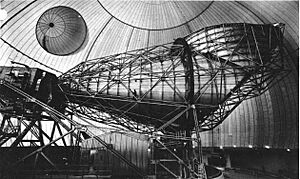Andover Earth Station facts for kids
The Andover Earth Station was one of the very first places on Earth to talk to satellites in space. It was built in 1961 by a company called AT&T in Andover, Maine, USA. Its main job was to communicate with the Telstar 1 satellite. Telstar 1 was the first satellite that could directly relay (send on) phone calls and TV signals.
This station helped make the first experimental satellite phone calls and TV broadcasts between North America and Europe. It also worked with another satellite called Relay. The huge antenna at Andover was taken down in the mid-1980s.
Contents
Why Andover Was Chosen
AT&T picked Andover as the perfect spot in December 1960. They looked for a place that was good for radio signals. The Western Maine Mountains helped block out unwanted radio noise.
Being in the Northeastern United States meant it was close enough to Europe for a short satellite path. It was also near existing phone and TV lines, making it easy to connect. The site needed to be big enough for the giant antenna and control buildings. They also wanted room to grow in the future.
Building the Station
Land for the station was bought in January 1961. Construction started quickly on May 1st. The buildings were finished and equipment was installed by February 1962. The station was ready to go by the spring of 1962.
AT&T and Bell Labs led this whole project. They provided the ideas, money, and hard work to make it happen.
The Giant Antenna
The radio transmitter on the Telstar satellite was not very powerful. It only used 14 watts, which is like a small light bulb! Because of this, the ground antennas needed to be huge.
The Andover Earth Station had a giant horn antenna. It was 7 stories tall and weighed 340 tons. To keep it safe from bad weather, a huge dome called a radome covered it. This dome was made of a special fabric called Dacron. It was 160 feet (49 meters) high and 210 feet (64 meters) wide. The dome itself weighed 30 tons!
Unlike today's satellites that stay in one spot (geostationary orbit), Telstar moved quickly across the sky. The giant antenna had to be able to move precisely. This allowed it to track the satellite as it flew overhead.
First Satellite Communication
Telstar 1 was launched into space on July 10, 1962. It took off from Cape Canaveral Air Force Station. The engineers at Andover Earth Station had to wait 15 hours for the satellite to come into view. Telstar traveled at 5 miles per second (8 km/s), about 3,000 miles (4,800 km) above Earth.
The engineers successfully sent a signal to Telstar. The satellite then made the signal 10 billion times stronger and sent it back to Andover.
Eugene F. O'Neill was in charge of the Telstar project at Andover. He said one of the hardest parts was aiming the antenna's very narrow signal beam exactly at the satellite. At 7:17 p.m., he excitedly announced, "We've acquired Telstar!" This meant they had successfully connected.
Just 14 minutes later, at 7:31 p.m., an American flag from Andover appeared on a TV screen. Then, at 7:47 p.m., engineers at Andover heard good news. The French station, Pleumeur-Bodou, had also received the TV picture! This was a huge step for global communication.
What Happened Next
The large radome was taken down in the mid-1980s. The land was returned to nature.
MCI bought the Andover Earth Station in 1987. Later, Verizon bought MCI in 2006, which included the Andover Earth Station. The site is still used today by Verizon's Satellite Solution group. It continues to support satellite operations for Verizon.
Images for kids
-
The immense horn antenna within the radome at Andover Earth Station. This type of antenna is called a Hogg or horn-reflector antenna, invented by Albert Beck and Harald Friis in 1941 and further developed by D. L. Hogg at Bell Telephone Laboratories in 1961. It consists of a flaring metal horn with a metal reflector mounted in the mouth at a 45° angle. The advantage of this design over a parabolic dish antenna is that it has very low sidelobes; that is, the horn shields the antenna from radiation from angles outside the main beam axis, such as ground noise.





